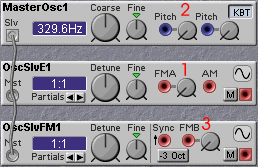 Frequency Modulation
Frequency Modulation Frequency Modulation
Frequency Modulation
by Jim Clark
Frequency modulation is exactly as the name implies, the frequency of an oscillator is varied in a regular way by another oscillator whose basic pitch changes proportional to the first oscillator. If you do this with a sinewaves the waveform of the sinus is affected and the timbre of the wave changes - it becomes 'complex'. Two frequency inputs to the oscillator are needed. The oscillator adds the two frequency values together, one value a `stable' one that controls the basic pitch of the waveform and the other varying to affect the waveform. The `stable' input should be logarithmic (=non-linear) to accomodate a keyboardvalue on the NM. If the modulating input however is also logarithmic (e.g. the Pitch input of a NM oscillator) the waveform shape, and therefore the timbre, changes if the pitch is increased. A low pitch will relatively be more modulated (have more harmonics) than a high pitch. This makes it not very useful for synthesizing a `physical instrument'-like sound. When modulating with a linear modulating input (e.g. the FMA input) the harmonic content will remain stable over the complete pitch range.
But what if we selfmodulate a sine-oscillator with the FMA-input? Opening the FMA-knob will not only change the timbre, but also the pitch of the sound. On the Yamaha FM-synthesizers however the pitch doesn't change when selfmodulating. This is because Yamaha uses `phase modulation' rather than frequency modulation. In this technique, it is not the frequency of the oscillator that is modulated but it rather the phase of the wave. On the Nord Modular a special sinewave-oscillator was introduced to be able to make Yamaha-like FM patches that apparently employs this phase modulation by means of the FMB input. Selfmodulating a FMB oscillator does not shift the pitch. As you can add or subtract (adding a negative value) to the phase, when the modulation-wave is in it's downward (negative) going phase the modulated wave is actually 'reversed', played backwards if you like. So it's like a short sample consisting only of one cycle of a sinewave, that is repeatedly played forwards and backwards. It is this 'backwards' playing that compensates for the pitchshift when selfmodulating.
So, in summary, FM has these three variations:

|
Liniar - logarithmic |
Phase - logarithmic |
Applying a constant value to the FM input will shift the pitch but the shift will stay proportional to the basic pitch in musical terms. The `beat' between two oscillators will be faster with higer pitches. Applying a constant value to the FMA input will shift the pitch by a certain amount of Hertz that doesn't change over the pitchrange. The `beat' between two oscillators will remain constant over the pitchrange. Applying a constant value to the FMB input will give no audible pitchshift, until you start varying the value. So the FMA and FMB `sound' the same to the ear, but behave differently with selfmodulation.
Frequency modulation provides an easy way to alter the harmonic content of a sound. The sounds of many instruments are characterized by the way in which their timbre changes over time. To generate similar sounds using FM is often merely a matter of varying the modulation level appropriately, using envelope generators or LFOs.
For example, to emulate Brass instruments using FM, set the frequency of the modulating signal to be the same as that of the carrier. Use an envelope generator to set the modulation level, resulting in the characteristic brightening of the timbre during the attack.
To model the sound of the Bassoon and similar instruments using FM, set the frequency of the modulator to a multiple of the carrier frequency. This will weaken the strength of the fundamental relative to the higher harmonics. All harmonics (odd and even) are present in these types of instruments, due to the tapered bore.
Instruments with cylindrical bores, such as the clarinet, have mainly odd harmonics. Conversely to the case of brass instruments, the timbre of the clarinet starts out bright then becomes duller during the attack phase. So use an inverted envelope generator to adjust the modulation level.